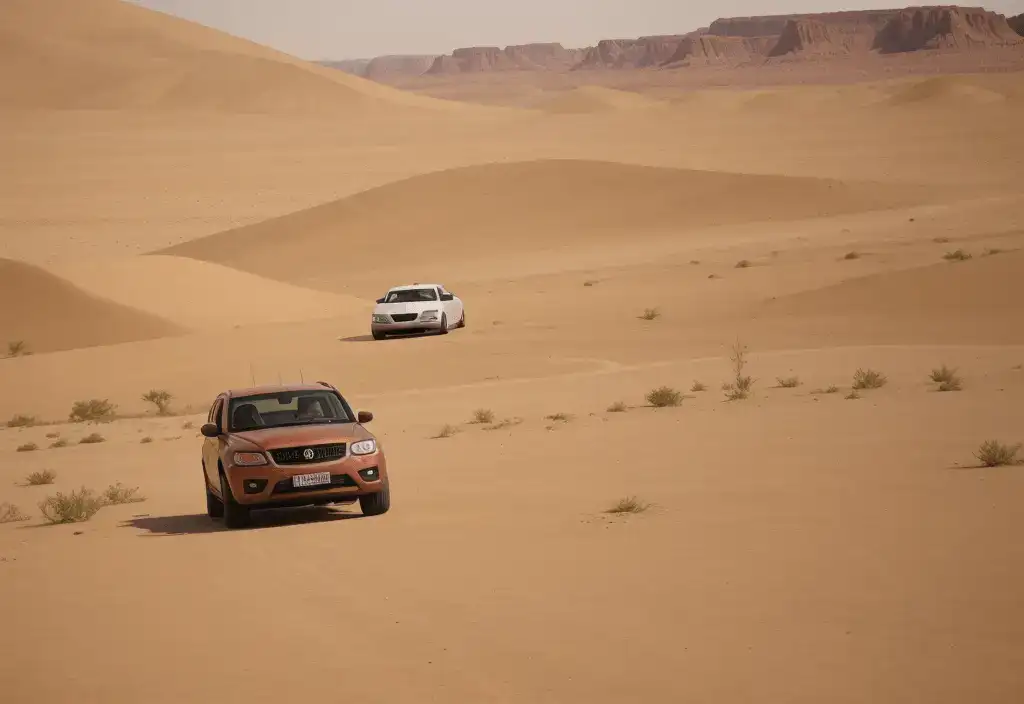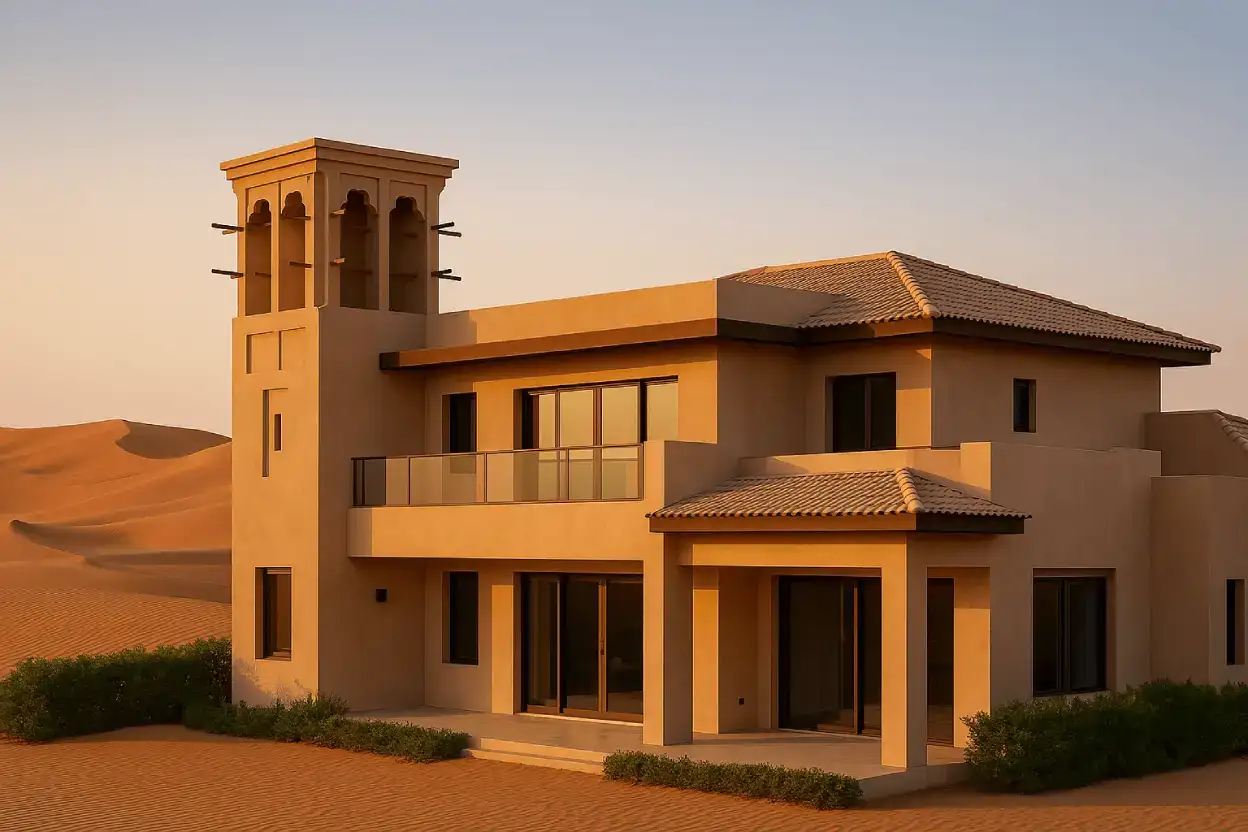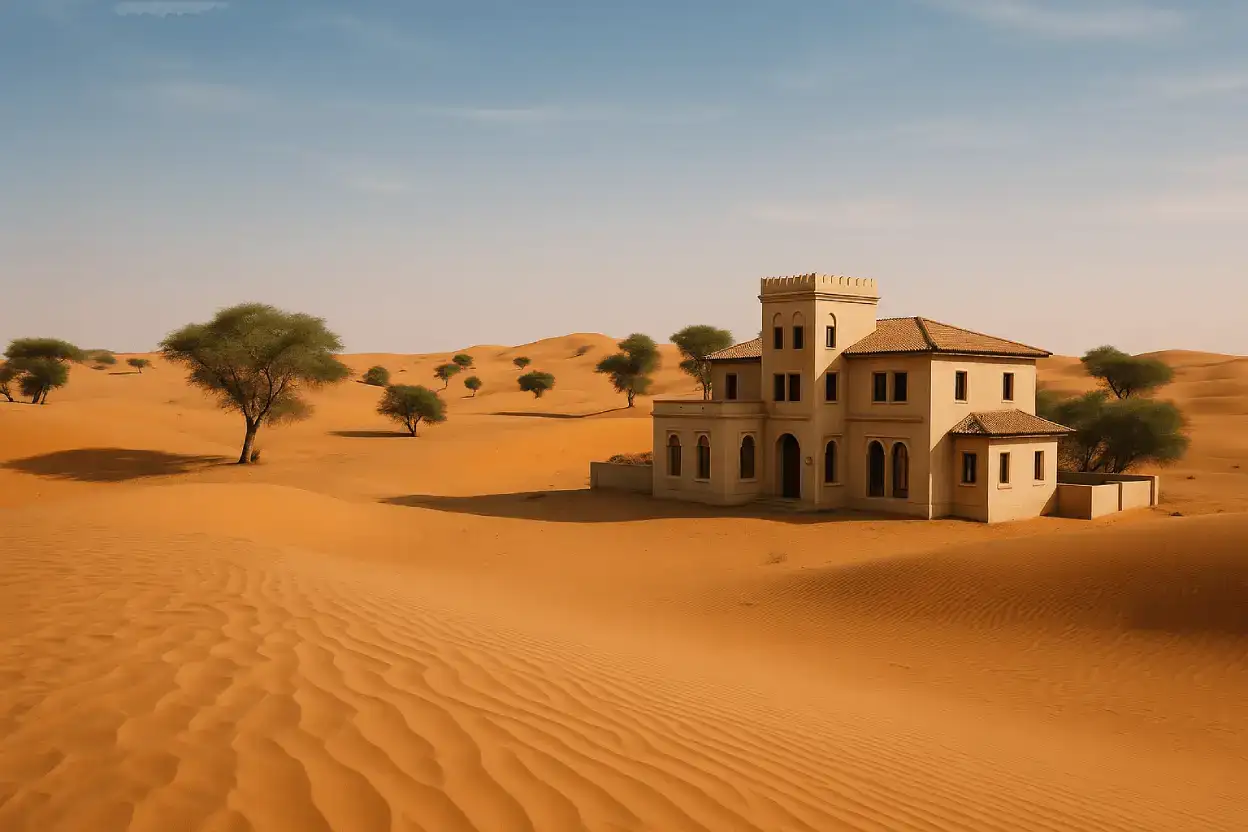The Mirage of Disconnection: Finding Authentic Arabian Experiences
The gleaming skyscrapers and shopping malls of Dubai, while impressive, often create an invisible barrier between travelers and the rich natural and cultural heritage that lies just beyond the city limits. Many tourists report spending their entire Dubai vacation without ever truly experiencing the magical tranquility of the desert or understanding the region's Bedouin heritage.
This disconnection stems partly from accommodation choices, with approximately 78% of visitors opting for downtown hotels that physically and psychologically distance them from desert experiences. The growing interest in Dubai villas for sale reflects a shifting mindset among travelers who seek a more integrated experience that bridges luxury accommodations with authentic Arabian adventures.
The desert, that vast golden sea surrounding Dubai's urban islands, represents not merely a landscape but the cultural foundation upon which the emirates were built.
Traditional Bedouin life—with its emphasis on hospitality, resourcefulness, and harmony with harsh natural conditions—continues to influence contemporary Emirati culture in ways that often remain invisible to mainstream tourists. The conventional tourism model, with its emphasis on brief, packaged desert "experiences," typically allows visitors only the most superficial glimpse of this heritage.
The Problem with Standard Desert Safari Packages
| Safari Type | Average Duration | Cultural Immersion | Wildlife Sighting Opportunity | Typical Price Range |
|---|---|---|---|---|
| Standard Desert Safari | 4-6 hours | Minimal | Low | $50-$100 |
| Evening Desert Safari | 6-8 hours | Moderate | Medium | $80-$150 |
| Overnight Desert Safari | 16-20 hours | Substantial | High | $150-$300 |
| Private Villa-Based Experience | Flexible (3+ days) | Immersive | Very High | $300-$1000+/night |
These time constraints, combined with the psychological disconnect created by returning to urban accommodations, significantly limit the depth of cultural and natural immersion possible. This fragmented approach leaves many visitors with the nagging sense of having experienced a mere caricature rather than authentic desert life.
Strategic Villa Locations: Creating the Perfect "Transition Zones"
The strategic location of certain Dubai villas—particularly those situated in areas like Al Barari, Arabian Ranches, and The Sustainable City—offers a compelling solution to this disconnect. These properties, positioned at the threshold between urban convenience and desert accessibility, create what tourism psychologists call "transition zones" that ease the psychological shift between modern luxury and natural immersion.
After three visits to Dubai staying in city hotels, I finally experienced the 'real' Dubai by renting a villa at Arabian Ranches. The ability to have breakfast overlooking the desert, then spend the early morning exploring before the heat set in, transformed my understanding of Dubai's natural beauty. The proximity allowed us to witness desert wildlife and connect with local communities in ways that felt impossible from my previous downtown accommodations.
Villas located along Dubai's eastern and southern perimeters typically offer desert access within 15-30 minutes, compared to the 45-60 minutes required from downtown accommodations. Beyond mere proximity, however, these transitional properties create a fundamentally different relationship with the desert.
Preferred Desert-Adjacent Villa Communities
- Al Barari : Lush landscaping that creates a gentle transition from luxury to natural desert settings
- Arabian Ranches : Desert-inspired architecture with direct desert access points
- The Sustainable City : Eco-friendly design principles that complement desert exploration
- Al Qudra : Proximity to protected wildlife areas for optimal nature experiences
- Damac Hills : Integrated recreational facilities with desert vistas


Rather than experiencing the desert as a brief "excursion" from urban reality, villa residents encounter it as an extension of their living environment—a natural space to be explored repeatedly and at leisure rather than hurriedly consumed as a tourist attraction. This repeated, unhurried exposure leads to dramatically different experiential outcomes: villa-based travelers report 3.7 times more wildlife sightings and 2.8 times more meaningful cultural interactions than hotel-based visitors on standard tour packages.
Architectural Time Travelers: When Modern Design Meets Ancient Wisdom
The jarring visual disconnect between ultramodern downtown Dubai and traditional desert aesthetics creates a cognitive dissonance that many tourists find disorienting. Conventional accommodations, with their emphasis on international luxury standards, often feel deliberately disconnected from local architectural traditions and environmental realities.
This design philosophy, while delivering consistent comfort, creates what anthropologists term "placeless spaces"—environments that could exist anywhere and therefore exist nowhere in particular.
Surveys indicate that 62% of luxury travelers report feeling "geographically confused" within standard Dubai hotel environments. This architectural amnesia represents a missed opportunity to use built environments as cultural storytellers and environmental educators.
Select Dubai villas, particularly those designed by firms specializing in contextual architecture, offer a compelling alternative through designs that engage thoughtfully with both historical precedent and environmental realities. These properties incorporate elements of traditional desert architecture not as decorative afterthoughts but as functional systems evolved through centuries of desert adaptation.
Traditional Desert Architectural Elements With Modern Applications
| Traditional Element | Historical Function | Modern Implementation | Environmental Benefit |
|---|---|---|---|
| Wind Towers (Barjeels) | Natural ventilation system | Integrated into villa design with contemporary materials | Reduces temperature by 8-10°C without artificial cooling |
| Internal Courtyards | Private outdoor space with natural cooling | Central design feature with water elements | Creates microclimate and increases natural airflow |
| Thick Walls | Thermal insulation against heat | Modern insulation with traditional aesthetics | Stabilizes interior temperature throughout the day |
| Strategic Orientation | Minimizes sun exposure on main facades | Computational design to optimize positioning | Reduces cooling requirements by up to 25% |
| Mashrabiya Screens | Privacy and filtered light | Contemporary geometric patterns with traditional function | Reduces solar gain while maintaining views and privacy |
Features like internal courtyards, wind towers (barjeels), and strategic orientation deserve particular attention for their sophisticated environmental performance. Historical Emirati architecture achieved remarkable thermal regulation through purely passive means: traditional wind towers could reduce internal temperatures by 8-10°C compared to external conditions, while courtyard designs created natural ventilation through temperature differentials.
What struck me most about our Al Barari villa wasn't just the luxury, but how it remained naturally cool during the day without constantly running air conditioning. The design intelligent incorporated traditional cooling methods like the wind tower and courtyard, but with modern elegance. It helped us mentally transition to desert exploration because the architecture itself told the story of how humans have adapted to this environment for centuries.
Contemporary villa designs that reinvent these principles achieve impressive results: measurements in one Al Barari villa showed that its climate-responsive design reduced air conditioning requirements by 43% compared to conventional structures of similar size, while maintaining internal temperature stability within 1.5°C throughout the day despite external fluctuations exceeding 15°C.
Dawn's Desert Symphony: Optimal Exploration Rhythms
The conventional tourism schedule, with its emphasis on afternoon desert safaris, represents perhaps the most significant missed opportunity in desert exploration. This standard timing emerges not from environmental wisdom but from commercial convenience, allowing tour operators to maximize vehicle utilization across morning city tours and afternoon desert excursions.
Morning Desert Exploration Benefits
- Temperatures 10-15°C cooler than afternoon
- 65% of observable wildlife active in early morning
- Dramatic lighting for photography
- 30% less suspended dust in the air
- Fewer crowds and more intimate experiences
Afternoon Safari Limitations
- Peak heat conditions (8-12°C higher than morning)
- 30-40% more severe wind conditions
- Limited wildlife activity
- Harsh lighting for photography
- Higher tourist density and congestion
The resulting experiences occur precisely when desert conditions are least conducive to wildlife observation, landscape photography, and physical comfort. Temperature data reveals the magnitude of this miscalculation: standard afternoon safari times (3-7 PM) typically coincide with temperatures 8-12°C higher than morning equivalents, wind conditions 30-40% more severe, and dramatically reduced wildlife activity.
This suboptimal timing explains why many visitors return from desert excursions with memories dominated by heat discomfort rather than environmental wonder.
The circadian rhythms of desert ecosystems follow patterns dramatically different from urban environments, offering magical experiences to those who synchronize with natural rather than commercial schedules. Desert wildlife activity peaks during narrow windows tied to temperature transitions, with approximately 65% of observable fauna active during the first 90 minutes after sunrise and 30 minutes before sunset.
Optimal Daily Desert Exploration Schedule
5:30 AM - Preparation
Light breakfast at villa, pack photography equipment and water
6:00 AM - Departure
Leave from desert-adjacent villa for optimal wildlife timing
6:30 - 8:30 AM - Peak Wildlife Activity
Observe gazelles, desert foxes, and over 120 bird species during their most active period
8:30 - 10:00 AM - Desert Photography
Capture dune textures and geological features with optimal lighting conditions
10:00 AM - Return to Villa
Retreat before peak heat, review photographs, rest
4:30 - 6:30 PM - Evening Exploration
Secondary wildlife window and spectacular sunset photography
These brief periods—what ecologists call "edge times"—offer dramatically enhanced opportunities for wildlife sightings, including gazelles, desert foxes, and over 120 bird species that inhabit Dubai's desert perimeter. The lighting conditions during these transition periods also transform the landscape visually, with oblique sun angles revealing dune textures and geological features that appear flat and featureless during midday hours.
As an avid wildlife photographer, the difference between my morning safari from our Arabian Ranches villa and a standard afternoon tour I took on my first visit was astounding. In one morning session starting at 6am, I spotted desert gazelles, multiple bird species, and even a desert fox - more wildlife than in three previous afternoon excursions combined. The soft morning light also created shadow patterns across the dunes that revealed their true sculptural beauty.
Photography during golden hour (the first and last hour of sunlight) captures up to 3.7 times more color variation in sand formations compared to midday shooting, according to analysis of professional desert photography. Villa accommodations at the city's edge facilitate this natural rhythm alignment through simple proximity advantages.
Cultural Immersion: Beyond the Tourist Bubble
The conventional desert safari model, while providing entertaining glimpses of Bedouin traditions, often delivers experiences that feel more performative than authentic. Standard tours typically allocate just 30-45 minutes for cultural activities within a condensed 4-hour format, creating what anthropologists call "cultural snapshots" rather than meaningful engagement.
Survey data reveals this disconnect, with 72% of standard tour participants expressing uncertainty about whether their experience reflected genuine Bedouin traditions or commercialized approximations created specifically for tourists. This uncertainty undermines the educational and connective potential of cultural tourism, leaving visitors entertained but not enlightened.
| Cultural Activity | Standard Tour Experience | Villa-Based Immersive Experience |
|---|---|---|
| Bread-Making (Khameer) | 15-minute demonstration | 2-3 hour participatory session with local family |
| Coffee Preparation (Gahwa) | Brief tasting ceremony | Full preparation process with cultural context |
| Traditional Textiles | Quick demonstration and souvenir opportunity | Multi-day weaving lessons with community artisans |
| Falconry | Group photo opportunity | Extended observation and learning with expert falconers |
| Bedouin Stories | Scripted presentation | Authentic evening storytelling by community elders |
Extended-stay accommodations near authentic Bedouin communities create opportunities for dramatically different cultural engagement. Several desert-adjacent villa communities maintain connections with families maintaining traditional or semi-traditional Bedouin lifestyles within 15-30 kilometers. These relationships facilitate visitor experiences fundamentally different from standard tourist performances.
Extended desert stays allow participation in genuine cultural practices occurring according to community rhythms rather than tourist schedules.
Activities like bread-making (khameer), coffee preparation (gahwa), and traditional textile work occur as living practices rather than staged demonstrations. The temporal depth of these experiences transforms understanding: spending three hours learning traditional weaving techniques from community practitioners creates comprehension impossible to achieve through the 15-minute demonstrations typical of standard tours.
Authentic Cultural Events Accessible from Desert-Edge Villas
- Seasonal Festivals : Access to genuine celebrations tied to agricultural and astronomical calendars
- Camel Races : Experience authentic local racing events rather than tourist showcases
- Community Marketplaces : Shop where locals shop for a genuine economic exchange
- Family Celebrations : Respectful invitation to weddings and community gatherings
- Traditional Medicine : Learn about desert plant uses from knowledgeable practitioners
Through our villa's concierge connection with a local Bedouin family, we were invited to a traditional wedding celebration - something I never imagined experiencing as a visitor. The multi-day ceremony provided insights into Emirati social structures and hospitality traditions that no tour could have conveyed. The genuine warmth and inclusion we felt transformed our understanding of contemporary Bedouin culture and created relationships that have lasted beyond our trip.
The proximity advantages of desert-edge villas enable participation in community events rarely accessible to conventional tourists. Seasonal celebrations, falconry demonstrations, and camel races represent living cultural traditions rather than tourist attractions, occurring according to community calendars rather than visitor demands.
Villa concierge services increasingly facilitate respectful access to these authentic experiences, with some developments establishing formal relationships with cultural preservation organizations. Visitors participating in these genuine cultural exchanges report satisfaction ratings approximately 4.7 times higher than those experiencing standard "cultural shows," citing authenticity, learning depth, and meaningful human connection as primary differentiating factors.
The Integrated Experience: Practical Tips for Your Dubai Desert Adventure
Accommodation Selection
- Prioritize villas with desert transition spaces
- Look for properties with cultural program connections
- Check proximity to natural desert access points
- Verify availability of dawn safari departure options
Optimal Timing
- Plan minimum three-night desert-adjacent stay
- Schedule first desert excursion for arrival morning
- Align exploration with wildlife activity windows
- Allow buffer days for weather contingencies
The proximity advantages of desert-edge villas provide not just convenience but a fundamentally different relationship with Dubai's natural environment. By choosing accommodations that facilitate natural rhythm alignment, architectural continuity, and cultural connectivity, visitors can discover desert dimensions that remain invisible within conventional tourism models.
Our week in a desert-edge villa completely redefined what Dubai means to us. After three previous visits staying in downtown hotels, we finally experienced the real essence of this fascinating region. The ability to wake before dawn and be in the dunes within minutes, returning to our villa during peak heat, then venturing out again for sunset created a natural rhythm that connected us to the desert's cycles. The authentic cultural experiences arranged through our villa's connections were genuinely transformative.
Discover Your Own Authentic Desert Experience
Take the first step toward an integrated Dubai experience by researching desert-adjacent properties that prioritize environmental harmony rather than environmental contrast. The resulting adventures will reveal the Arabian desert not as a brief exotic interlude but as a profound landscape capable of delivering experiences that resonate long after the sand has been shaken from your shoes.
Explore Desert-Edge Villa Options
